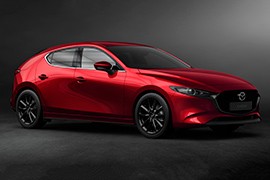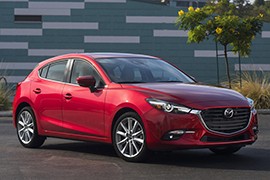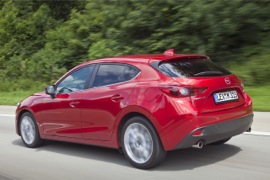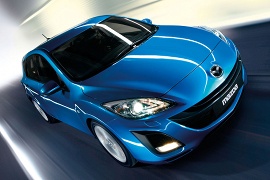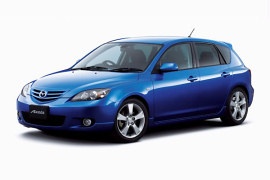MAZDA 3 / Axela Hatchback Models/Series Timeline, Specifications & Photos
First production year: 2004
Engines: Diesel, Gasoline
Body style: Hatchback
Mazda introduced the fourth generation of the 3/Axela at the 2018 Los Angeles Auto Show and was offered as a 2019 model-year worldwide.
This nameplate was one of the most important in Mazda's inventory since it was the one that could provide big numbers. But while other automakers made their compact-sized vehicles in more shapes, such as coupes, convertibles, and wagons, the Japanese automaker focused on the sedan and five-door hatchback form.
Following the Kodo design language introduced in 2010 and already present on the CX-9 or the 6, the 3 hatchback featured similar flowing lines over its bodywork. The Japanese designer Yasutake Tsuchida penned the vehicle with swept-back headlights and a broad pentagonal grille at the front. In addition, the aggressive front fascia also featured a small lip spoiler placed at the bottom of the lower bumper. Unlike its sedan sibling, the 3 had an arched rear end with very wide C-pillars and a Kammback styling for the tailgate.
Inside, the 3 featured a double level design and the 8.8" infotainment screen rising up in the middle. The designer installed the controller for it on the center console, a rotary knob. In addition, the automaker provided large round dials mounted on the dashboard, in the middle, for the HVAC system.
The 3 featured engines, either gasoline or diesel, ranged between a 1.8-liter and 2.5-liter displacement. All versions were assisted by Mazda's new M Hybrid system, which increased fuel efficiency and driving experience. The standard transmission for the entire range was a 6-speed manual, while a 6-speed auto was on the options list. The platform offered a front independent suspension and trailing arm in the rear. An all-wheel-drive version was available as well, but still without an independent suspension in the back.
The 2016 Mazda 3 is one of the most important contenders in the compact hatchback market. It has a lot of things to offer and a few things to ask. Its name in the JDM market and China is Axela, but basically, it is the same car. It has a nice, fluid, look, called Kodo design in the Mazda's family. Now, the Mazda 3 has separated itself from the Ford's C platforms and came with its platform that features a McPherson strut up front and a semi-independent system in the rear. But even if they tried their best to make that rear suspension behave good, it is still not an independent suspension.
Inside the cabin, there is room for five adult people and the whole atmosphere is kind of relaxing. The infotainment unit is planted on the dashboard like it was installed after the car left the assembly line. It is not that big or small and has decent controls via a rotating knob.
Under the hood, Mazda installed a range of four gasoline engines and two turbodiesels. Depending on the market and engine displacement, the 3 can be equipped with a 6-speed manual, a 4-speed automatic or a 6-speed automatic. The latter is offered as standard on the 2.5-liter engine. And that is the version to aim. Or, if you live in Europe, the 1.5-liter turbodiesel is a very decent version. Just don't forget that underneath the car is not an all-wheel independent suspension.
After Ford's era, Mazda rejoiced its freedom again and put passion back in its cars. Even though the 3 was not exactly the kind of car that should inspire some emotions, it did. And the 2013 model proved it.
Thanks to its sporty appearance and its fluid bodywork lines, the 3 was a commercial success all over the world. While the sedan version was more or less desirable by those who wished to have a three-box sedan vehicle, the hatchback was the one that ignited younger buyers' imagination.
The 2013 model year was shorter, wider, and lower than its predecessor. Its entire bodywork was stiffer by 28 percent, and that was reflected in the cornering speed. With its design language, named Kodo, the carmaker introduced the shield-like grille flanked by the angular, eye-shaped headlights. At the bottom of the front bumper, the apron featured an additional grille with two foglights on the sides. Its ascending beltline and the curved-down tailgate at the back offered a sporty appearance, almost like a hot-hatch.
Inside, not all materials were of top quality, but there were no cheap ones either. Its dashboard was simple, plain, with only a few buttons on sight, on the center stack. A floating infotainment display was in the middle of the dashboard, and the driver could access it from the steering wheel's buttons or from the rotary knob placed on the center console. The front bucket seats were designed to win a beauty contest, and their minimal bolstering reminded the front occupants that it was a family car. The split-folding rear bench made room for three thin passengers.
Under the hood, Mazda offered the 3 with a choice of four engines mated to either a six-speed manual or a six-speed auto.
MAZDA 3 / Axela Hatchback 1.5L SKYACTIV-G 6MT FWD (100 HP)
MAZDA 3 / Axela Hatchback 2.0L SKYACTIV-G 6AT FWD (120 HP)
MAZDA 3 / Axela Hatchback 2.0L SKYACTIV-G 6AT FWD (155 HP)
MAZDA 3 / Axela Hatchback 2.0L SKYACTIV-G 6MT FWD (120 HP)
MAZDA 3 / Axela Hatchback 2.0L SKYACTIV-G 6MT FWD (155 HP)
MAZDA 3 / Axela Hatchback 2.0L SKYACTIV-G 6MT FWD (165 HP)
MAZDA 3 / Axela Hatchback 2.5L SKYACTIV-G 6AT FWD (184 HP)
MAZDA 3 / Axela Hatchback 2.5L SKYACTIV-G 6AT with i-ELOOP FWD (184 HP)
Mazda took its own path after splitting with Ford due to the world financial crisis when the blue-oval brand sold most of its stakes in the Japanese carmaker.
The 2009 Mazda 3 was based on the previous model, developed together with Ford. But the changes brought to the model were extensive and important. In addition, the car came with a new design language, known as Zoom-Zoom. Some of the important improvements over the previous generation were the standard introduction of the ABS on all versions, starting from the base trim level.
With its fresh design cues that combined arched lines with sharp angles, the 3/Axela featured a broad grille at the front flanked by a pair of scoops that sported the fog lamps. On its sides, the flared wheel arches and the ascending lines sculptured on the door panels created the image of a sporty vehicle. In its hatchback shape, that was confirmed even more by the MPS version, which featured a bulge on the hood and a distinctive roof spoiler on top of the tailgate.
Inside the vehicle, a new dashboard with higher quality materials was installed. Some of the buttons and controls were rearranged for better ergonomics. A Multi-Information display was installed atop the center stack. It included navigation, audio, and trip computer information.
For the U.S. market, the Mazda 3 Sedan offered two engine choices, while in Europe, the car was offered with a wider choice, both diesel and gasoline units. On the North American continent, the Mazda 3 was fitted as standard with automatic transmission on the top, a 2.5-liter engine.
Mazda replaced the 323 lineup with the 3/Axela in 2003 for the JDM market, and in the following year, it launched it for international customers.
Fitted with a completely new platform shared with the second generation of the European Ford Focus, the 3/Axela was available in two body versions: hatchback and sedan. While it wasn't a revolutionary vehicle, it enjoyed great success thanks to its design, suspension, engine lineup, and competitive price.
Following a new-edge-design styling, the 3 featured a dynamic look but not aggressive. Its pentagonal-shaped grill featured two body-colored slats and the automaker's chromed badge. In the lower bumper, Mazda installed an additional grille flanked on the sides by scoops for the fog lights. For the hatchback, the carmaker used different doors than the sedan due to the roof's shape. Behind them, the carmaker added a third side window, which increased the driver's three-quarters visibility.
Inside, the 3/Axela featured a curved dashboard with three binocular-style clusters for the instrument panel, with the speedometer in the middle and the tachometer on the left. The right side was for the coolant temperature, fuel level, and a small, monochrome LCD. Its front bucket seats with decent side bolstering provided good lateral support for its occupants. At the same time, the rear bench was suitable for two adults and a child in the middle. As expected in any hatchback from those times, the rear bench was 60/40 split-folding and expanded the trunk area from 346 liters (12.2 cu-ft) to 878 liters (31 cu-ft).
The independent suspension in all corners distinguished the 3/Axela from most competitors. Thus, Mazda provided a comfortable vehicle even for the passengers seated in the rear. Yet, that solution affected the trunk space.
